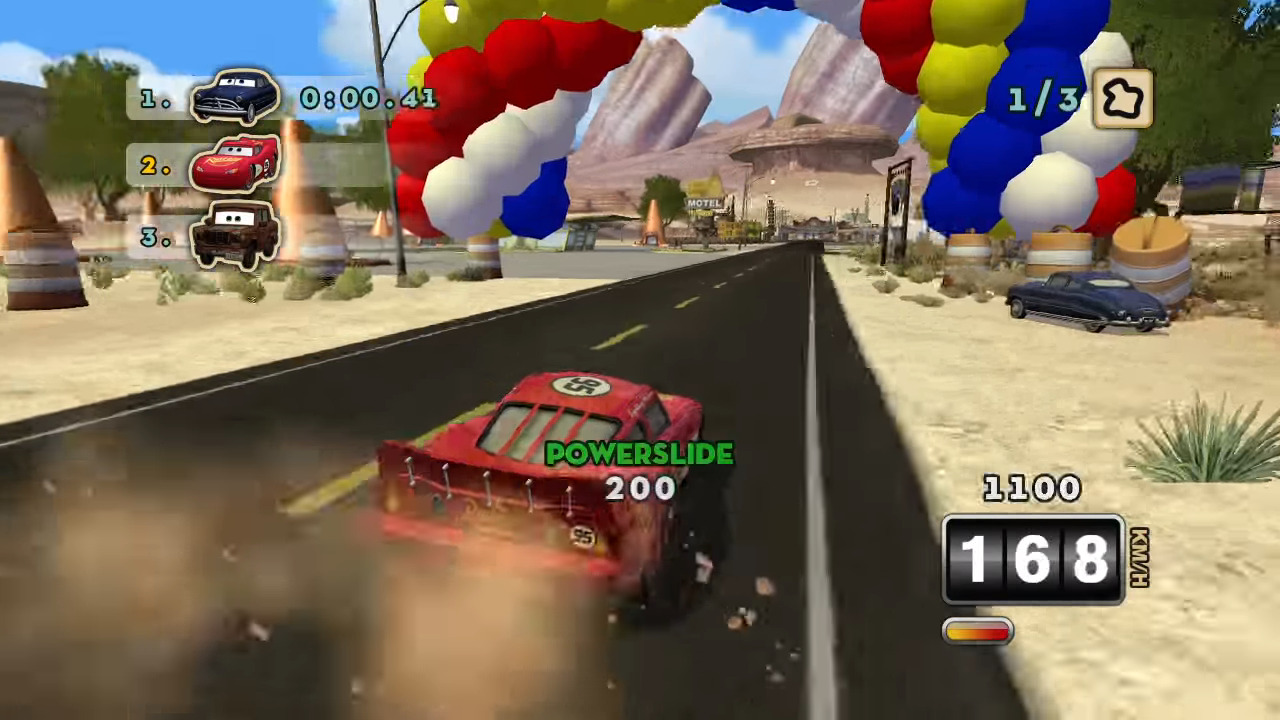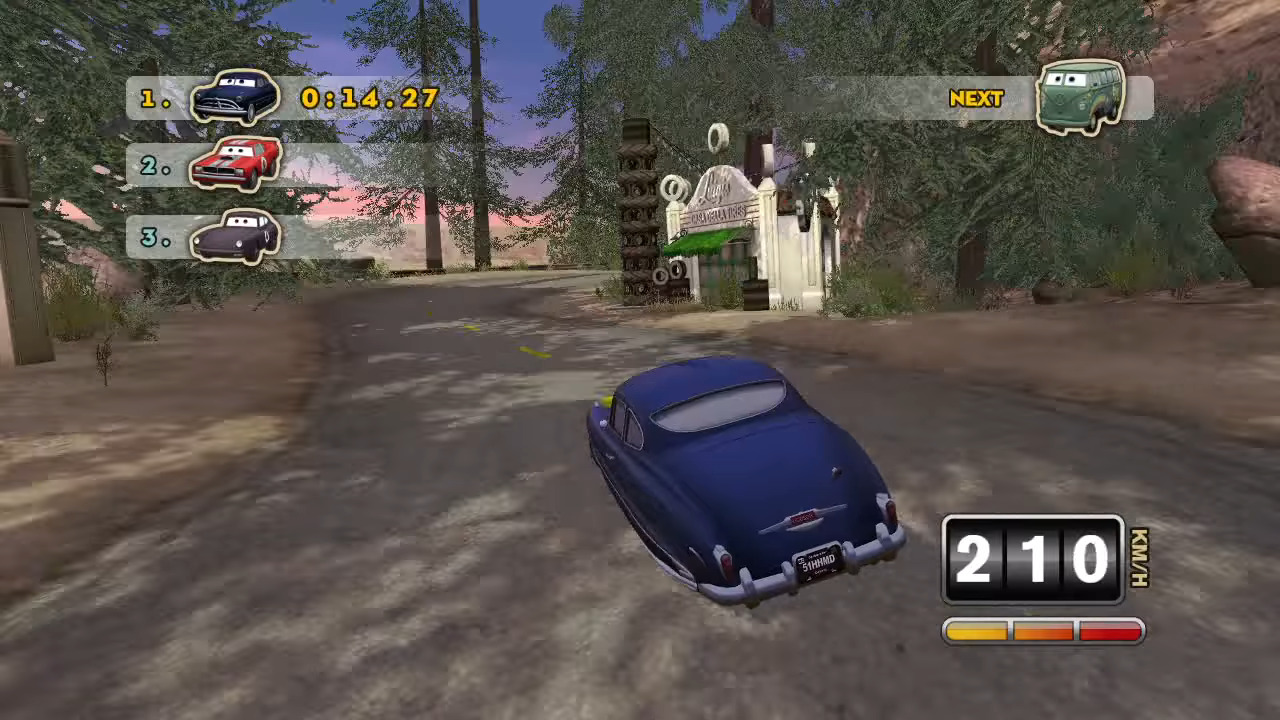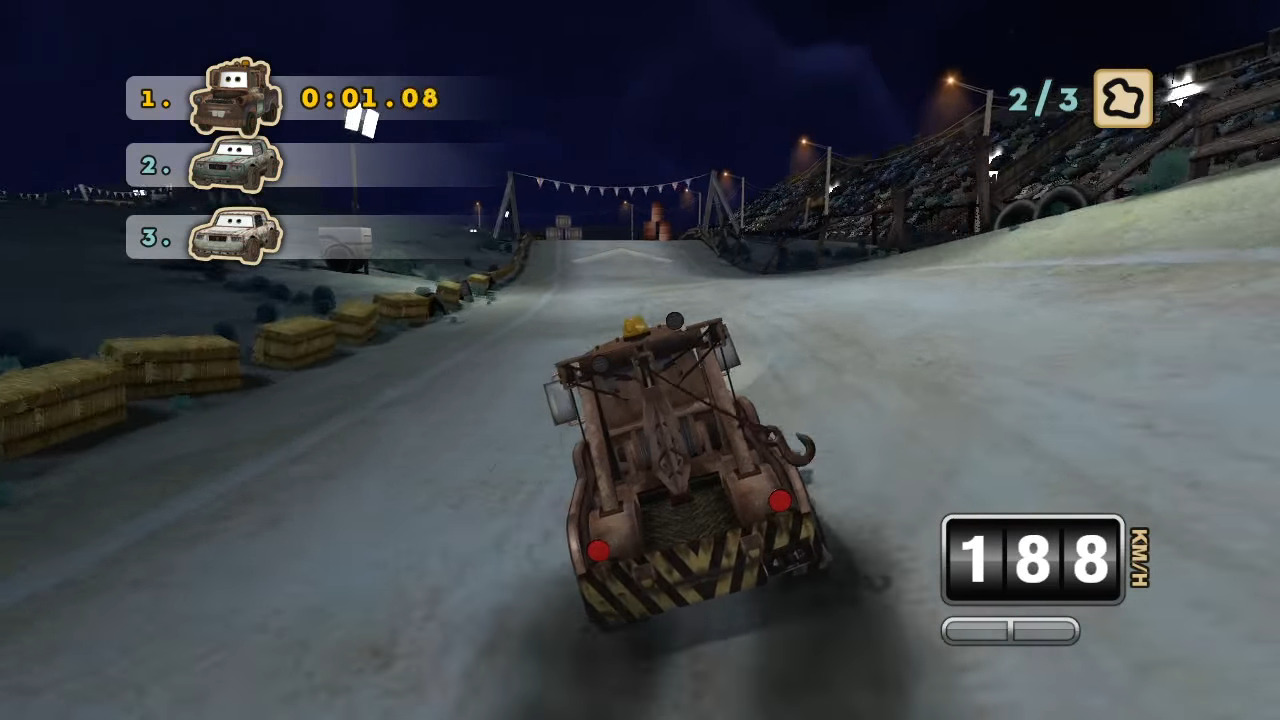Cars: Mater-National Championship (PS3)
After Pixar’s Cars film became a merchandising juggernaut thanks to the intersection of Disney’s marketing power and the inherent popularity of cars with children, it was little surprise that Disney wanted a sequel. Coming five years after the original film, the sequel would elevate comedy relief tow truck Tow Mater into a more prominent role as well as the story’s focus changing to meeting new characters from around the globe thanks to the original film’s protagonist Lightning McQueen participating in an international racing competition. Despite this working as an introduction to Cars 2, this simplistic description also works fairly well as a description of Cars: Mater-National Championship for PS3. This title, released 4 years before Cars 2, is itself a sequel, the follow-up to the video game adaptation of the first film, but while Cars 2 decided to go for an international spy route for its movie about living automobiles, Cars: Mater-National Championship kept things a bit closer to the racing focus the first film and game went with.
In Cars: Mater-National Championship, Lightning McQueen is hosting an international racing contest in the town of Radiator Springs to help keep the sleepy town on Route 66 alive, but the racing hot shot’s best friend Mater manages to contribute with his unique perspective on things such as accidentally renaming the event after himself after he struggled with its real name. As the stadiums for the race are set up though, Lightning McQueen and Mater busy themselves in the immediate area, interacting with their friends and meeting with racers from around the globe who end up racing them one way or another. Lightning is certainly the main character, handling most of the races in the game’s story mode and being the character you drive through the game’s small open world hubs with, but Mater has his own batch of races and minigames as well.
There really isn’t too much to the story besides a few moments setting up certain racing events or minigames and checking in on the progress of setting up the Mater-National, but the cutscenes do have some fun humor to them that might amuse younger audiences with a decent amount of the cast from the 2006 animated film reprising their roles. Larry the Cable Guy returns as Mater which feels the most important character to retain due to his distinctive voice and frequent role in providing comedic moments, but we also have less important characters have their star voice talent attached like Tony Shalhoub as Luigi and Cheech Marin as Ramone. Surprisingly, Lightning McQueen’s voice actor is not Owen Wilson despite being a dead ringer for him, Keith Ferguson doing a surprisingly good job stepping into the role.
The Story Mode unfolds across three main hub areas. You start in Radiator Springs, the small roadside town’s races focusing on its nearby deserts and canyons. Ornament Valley isn’t actually too different in concept but there are far fewer buildings and the focus for race tracks in the area is on distinctive segments like moving through the airport or a much tighter canyon where the rocky sides push in close. Tailfin Pass is a nice change of visual aesthetic though, the mountainside filled with trees and bridges that almost give it a Pacific Northwest feel that stands out from the Arizona inspired topography of the other locations. Exploring around these areas is given a practical purpose in that you need to find your next mission to participate in through driving around as Lightning, although the map screen can let you quickly access all but the most important races in an instant. Driving around the areas can also provide bonuses though, the player able to collect new paint jobs and stat-impacting tires by exploring. Points are also littered about in the form of collectibles that regenerate on each repeat visit, these going towards buying the unlockable racers, paint jobs, and other goodies that are available for use in the Arcade’s straightforward racing and minigames and Versus mode’s multiplayer competitions. The hub areas can still feel too wide open and empty despite the hidden goodies, but getting to mess around between story missions at least lets you have a low pressure breather with the potential for some simple rewards.
Of the available missions in Story Mode, the races are definitely given the most love and are surprisingly well built for it. The handling is responsive and actually contains a few maneuvers that let you better handle the race courses as turns become tighter or the opportunities for shortcuts arise. Powersliding is a classic drift mechanic where you can tighten how you take turns to avoid losing speed, but tilting your car so it balances on one half of its tires allows for an incredibly quick shift in direction. Tilting is good for a snap adjustment of your movement since it can’t be maintained long and messes with your speed more, but powersliding lets you take the longer turns without sacrificing control or speed. Jumping is a fairly appropriate maneuver for living cars to utilize and lets you hop over obstructions or other racers, and your boost tanks will refuel over time and can be used to get a speed boost when you need it, some shortcuts available if you boost our jump correctly.
The designs for the main course are rather sound as well, featuring split paths, shortcuts, risky portions, and a wide variety of turn types. There’s a good balance of straightforward racing areas and portions that ask for more finesse if you want to gain an edge over racers taking the more careful routes, your set of four main techniques all having areas they can shine if utilized properly. They even manage to feel rather distinct even when they place in similar hub areas like Radiator Springs and Ornament Valley, and the Rustbucket Challenges that Mater gets to tackle utilize a unique rugged stadium to contrast Lightning’s polished stadium challenges. Unfortunately, even in some tracks with huge offroad options for cutting corners, the game wants you to follow the road and will teleport you back to it if you try to be too creative with your driving lines. The AI racers you are up against in these races vary in quality mainly because you can adjust your difficulty on the fly with no penalty. The easy and normal difficulty equivalents aren’t too difficult to beat, but the hard difficulty stand-in actually has the other racers put up a fairly good fight and require the player to master a course if they want to win all of the story’s main races.
The backing music while you race can get rather repetitive due to a rather small selection of songs being featured, quite a few of them being rather plain instrumental pieces that do a fine enough job setting the mood of an energetic race but keeping odd company with licensed tracks like Rascal Flatts’s “Life is a Highway” and Apollo 440’s electronic track “Stop the Rock”. Perhaps stranger is the presence of “What I Like About You” by The Romantics for only Mater’s four Rustbucket Challenge races when adding it to regular rotation would help keep the game’s music from stagnating so quickly.
Were we just looking at the basics of Cars: Mater-National Championship that have been covered so far, we’d have a pretty solid racing game with some recognizable Disney characters done decent justice. However, the game’s story mode isn’t just straightforward racing, the game featuring a system where your performance in various challenges unlocks Bolt Banners, the game’s indicator of progress. Many of these Bolt Banners are tied behind minigames and racing variations, and even if you have your difficulty set to the easiest or the hardest options, some of these appear to entirely ignore it in their design. This can mean, no matter where in skill level you land in the game’s estimation, you still might be slogging through a plethora of ridiculously easy challenges or slamming yourself against a wall in the more difficult ones, making for a far less even experience overall and one that doesn’t always utilize the strong racing mechanics for these side activities.
Starting with the ones that do tie into racing somehow, there are a handful that are basically gimmick races with small aspects changed. Relay races involve you changing the car you drive every lap and one racing style involves you needing to pick up gasoline as you try to complete a certain amount of laps before you run dry. The gasoline one doesn’t require you to beat other racers though so you can easily chart a path to avoid an empty tank and the relay races are mostly just recycling tracks since the racers don’t feel so different you’ll need to adjust immensely to win, but the monster trucks that have their own set of races do play very differently. Bad at turning and often racing across hilly terrain that leads to plenty of bouncing around, the monster truck races can almost be nauseating with how belligerent your vehicle feels as it overreacts to the terrain. Doc and the Law’s Race ‘n’ Chase on the other hand mostly falls short because of its premise of needing to tag the other racer so they’re “It” before heading to your destination. The initial tag is usually pretty easy, but if the enemy can tag you back they can sometimes be practically impossible to catch up with, especially in courses that have the opposition’s destination much closer than yours to turn things against you.
In an odd choice for a minigame, Cars: Mater-National Championship takes a credits gag from the Cars film and has the monsters Mike and Sulley from Monsters Inc. show up as playable cars in a mode called Mike and Sulley’s Last Laugh. Here you need to maneuver the zippier Mike vehicle around to grab canisters before the monster truck Sulley can grab them but he can be a bit of a pushover and isn’t as maneuverable as you to make this one of the minigames that just sort of eats up playtime rather than engages the player. Ramone’s Rhythmic Rumble is a rhythm game where you press buttons in time with music that breaks away from the gameplay style of the rest of the game, and Tractor Tipping also involves a genre shift in that it’s a stealth minigame where you need to surprise the cow-like tractors without the harvester catching you. Ghosting Mater definitely stands out as the worst minigame though, and while you don’t need to do everything to beat the game, this one can feel practically impossible as it involves guiding Mater with the right and left directions inverted, the player not at all in charge of how fast he moves, and the mechanic of having him glide on momentum from the bursts of speeds he gets from checkpoints where a ghostly light frightens him enough to send him zooming off. I actually have no evidence of anyone beating all of Ghosting Mater in the PS3 version of the game so perhaps it is bugged in the port, so if you want to 100% the game it seems the PC or Wii version might be better since I have concrete video evidence of it being possible in those versions of the game.
With all these minigames and racing variations piled onto Cars: Mater-National, things become a bit less of an even experience overall, especially with the difficulty spikes and drops associated with these less polished forays into different play styles or gimmicks. Most of the minigames have very few levels and their associated unlockables are usually tied to minigame activities so you won’t be forced to play a minigame you don’t like, but they definitely drag down the overall fun you’ll have with the experience because of their variable quality.
THE VERDICT: Cars: Mater-National Championship is a solid racer with a few good maneuvers to add depth to the racing and tracks that reward the player for pulling off such techniques with alternate routes and shortcuts. The variable difficulty allows these racers to put up a good fight even for a seasoned racer, but the good racing is joined by a mixed bag of other play elements that hold this game back. The rather plain hub areas and the minigames that vary wildly in quality crop up between the races and make for a rather bumpy road to game completion, but the optional nature of much of the worse stuff means you can still squeak out quite a decent experience from this title whether or not you’re a fan of the brand it’s associated with.
And so, I give Cars: Mater-National Championship for PlayStation 3…

An OKAY rating. If you have a kid who loves racing games or the Cars brand, this game comes highly recommended in a case of a game that is a perfect fit for younger players while still being fairly decent for older gamers. The racing mechanics and courses work together well and the difficulty you can adjust on the fly allows for players to find the sweet spot in what they want to face in terms of capable opponents. The gimmick races like the fuel-focused one are a bit too caught up in their idea to utilize the strengths of the core racing, but when it’s you up against the other living automobiles in a regular race, the gameplay design does its job and ensures you’re challenged well. However, then you pile in concepts like the monster trucks, Ghosting Mater, and gameplay shifts to rhythm game mechanics or the stealth puzzles of Tractor Tipping and the game can feel all over the place. Optional content like exploring hubs isn’t as interesting as it could have been, and the amount of time you spend racing versus participating in other activities starts to skew a bit too much away from the point where this Cars game could earn a better rating.
Cars: Mater-National Championship was pretty much trying to carry on the brand before the second film in the series could come out, and while some of its story beats line up in a rather cute way with Cars 2, Cars: Mater-National Championship does sort of share that film’s mistake in shifting some of its focus to less interesting content. Mater-National does keep racing at the forefront at least, but it gets a little lost in all the other concepts it wants to cram in regardless of whether they work well. Since most of the game can still tie into the solid driving mechanics you still come out with something enjoyable enough to play, but the detours do keep you from fully appreciating what the racing has to offer.



